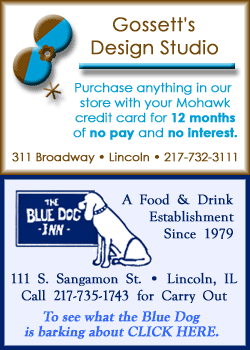|
Now,
148 years later, the Illinois State Fair draws approximately one
million people to the city of Springfield, making it the leading
tourist attraction in the city and drawing as many people during its
10-day run as the Lincoln Home and Lincoln Tomb combined. But the
carnival rides, food and entertainment options are just as likely to
draw people to the fair these days as the livestock and produce
competition and farm equipment displays.

"The
major emphasis and participation from the agriculture community was
at its high when it began. In the early 1980s when there were a lot
of farmers going under, it diminished. Thatís where the challenge
is Ė I donít think it will ever have the same visibility it had
in the early days, because farmers are different. The challenge
before us is to at least have a pleasurable experience for the
person coming to the fair, but at the same time, educate them to the
plight of the farmer. We have an obligation," Bud Ford, state
fair manager, said.
Ford,
who is in his second year as manager, admits that attendance figures
are less than scientific, but says, "I know last year, the
first Saturday exceeded 160,000 people legitimately, and it was
probably the busiest weekend day they ever had. Everyone that comes
to the fair I view as a special interest. The agriculture community,
and rightly so, come here because itís a tradition, itís a
celebration. We have an obligation to put this on.
"Itís
more than just carnival rides, grandstand, livestock," he said.
"People get a twinkle in their eye when they start talking
about the fair. They canít tell me the one thing they like; itís
a happening. Itís a 10-day extravaganza in their mind, that they
look forward to, especially in this community."
Ford
said the biggest challenge facing the fairís success is an entity
left to chance Ė the weather. "Weíll exceed a million
(people) this year, weather permitting. We can do the best job we
can possibly do, but we canít control the weather. I told my staff
last year, donít get down if it rains 10 days or if itís too
hot. We can control what we offer and we can do publicity, but we
canít control the weather. This year, I feel we have exceeded even
my expectations. I didnít know how we would top last year,"
said Ford, who did have to watch a severe thunderstorm hit the
fairgrounds last year, during the opening night parade.

Agriculture
machinery exhibits and livestock judging are now just one part of
the fairís emphasis. Vendors sell a large variety of food items,
from the traditional corn dogs and lemonade shake-ups to Cajun
shrimp on a stick, turkey legs and alligator tail. A Taste of
Illinois tent was so successful in its first year at the fair last
year, itís been expanded and will offer more Illinois foods and
beverages and nightly music by Chicago blues bands. A new tent this
year sports a Key West theme, a personal request by Ford, who is a
Jimmy Buffet fan.
(To top of second
column)
|
|
The Illinois
State Fair |
|
Address:
P.O. Box 19427, Springfield, IL 62794-9427
Phone:
217/782-6661
Fax:
217/782-9115
Web
site: www.state.il.us/fair/
E-Mail:
pio@agr.state.il.us
State
Fair Manager:
Bud Ford. The fair is a division under the Illinois Department
of Agriculture, director Joe Hampton.
Annual
budget: $4
million
Annual
attendance:
estimated one million people
Full-time
employees: 11
Part-time
employees hired by the state fair office during the fair:
300. The Department of Agricultureís building and grounds
department hires an additional 400 people.
Number
of volunteers:
150-200
Number
of animals:
12,000 species at any given time
Amount
of manure hauled away during the 10-day fair:
1,198 tons
|
The
fair also features a variety of music, food and events for people of
all ages Ė from Happy Hollow, with carnival games and rides to
cooking demonstrations and high-diving acts; baboons to ballroom
dancing; 4-H exhibits and pig racing to international cuisine and
wine judging.
Each
day of the fair focuses on a theme, including county fair and horse
racing; city of Chicago and local officials; veterans; senior
citizens; agriculture; the governor; Democrats; park district
conservation and family/violence prevention.

Some
people even go to the fair just to see the famous butter cow Ė an
unofficial icon of the fair since the 1920s. Five hundred pounds of
unsalted butter is used to sculpt the life-size figure by hand over
a wire and wood frame. The process takes about two days and is
featured in the dairy building.

Ford
said last year was the first year the grandstand made a profit.
"It had never paid for itself. The maximum it ever brought in
was $600,000 to $800,000. Last year, we brought in $1.7 million. Our
parking and gated admissions brought in an excess of $1 million.
Concession stands, which pay (the fair) 10 to 15 percent of their
profits, brought in over $1 million. Corporate sponsors donated
about $200,000," he said.
(To be continued)
[Penny
Zimmerman-Wills]
|



